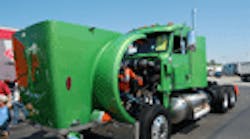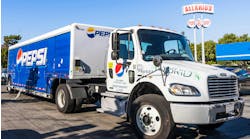KENLY, NC . As more and more fleets think about using different kinds of alternative fuels to power their trucks, from natural gas to biodiesel, they’ll need to make other maintenance and operationaladjustments as well, according to Shell Oil experts.
“Using alternative fuels can make a difference in terms of what type of engine oil you use or, more likely, the drain interval you need to follow,” said Chris Guerrero, global brand manager for Shell’s Rotella engine oil products line.
In an interview with FleetOwner at Shell’s 2011 “Super Rigs” show truck competition held here at the Kenly 95 Petro truckstop, several Shell executives stressed that a changeover to alternative fuels requires a variety of large and small adjustments to a fleet’s operation.
(Related content: See photos from the Shell 2010 "Supre Rigs" competition)
For example, Dan Arcy, Shell Lubricant’s OEM technical manager, noted that trucks equipped with spark-ignited natural gas engines need to use a low-ash engine oil formulation – one that produces ash amounts even lower that the CJ-4 blends designed for 2007 and 2010 emissions-compliant diesel engines.
“Take Cummins’ ISL-G truck spark-ignited truck engine that typically is powered by compressed natural gas (CNG),” he said. “Cummins wants a much lower ash engine oil formulation for that engine of around 0.6%, compared to the 1% ash level of CJ-4.”
That’s one reason why Shell developed its T3 NG 15W-40 motor oil, which it introduced in February last year.
However, for high pressure direct injection (HPDI) truck engines that use diesel fuel to “pilot ignite” the natural gas in the combustion chamber, CJ-4 engine oil should be used with a drain interval of 25,000 miles, Arcy added.
Biofuels, however, create a different set of issues, he pointed out. “In the case of biodiesel, the ‘organic’ material in the fuel can leave deposits that may affect engine oil viscosity,” Arcy said.
For engines using B20 or lower biodiesel blends – where biodiesel makes up 20% or less of the overall fuel mixture – the standard 25,000 mile CJ-4 oil drain interval applies. However, for B50 blends and above, where biodiesel represents 50% or more of the fuel mixture, much shorter drain intervals are recommended, Arcy stressed.
He added, too, that the “source material” for biodiesel could affect drain interviews as well. For example, soybeans are predominantly used in the U.S. to make biodiesel, whereas in Europe rapeseed is the predominant material, changing yet again to palm oil in South America.
“This is also where oil analysis becomes a big player,” stressed Guerrero. “Regardless of how much biodiesel is used in the fuel mixture, a fleet needs an oil analysis program to verify that the motor oil’s viscosity is holding up as expected.”
Stepping back to look at the big picture, Tom Yu, Shell’s business development manager for LNG (liquefied natural gas), noted that fleets must take a “life cycle view” when contemplating a changeover to natural gas or other alternative fuel options.
“There are definitely fuel cost savings for fleets, especially in the case of natural gas, but there’s a significant upfront investment cost hurdle that fleets need to cross first,” he explained.
For example, in California, natural gas right now costs the equivalent of $1.10 per gallon, compared to well over $4 per gallon for diesel fuel. Yet trucks designed to run on natural gas – either CNG or LNG – costs significantly more than their diesel-only counterparts and the refueling infrastructure necessary to support them is still lacking in much of the U.S.
“The lack of a natural gas refueling infrastructure in North America is the real barrier to wide use of it as a transportation fuel,” Yu said. “Natural gas itself is widely abundant in North America, is a very clean fuel in terms of emissions, and is very affordable. But it will only really take off when an adequate refueling infrastructure gets put in place.”



